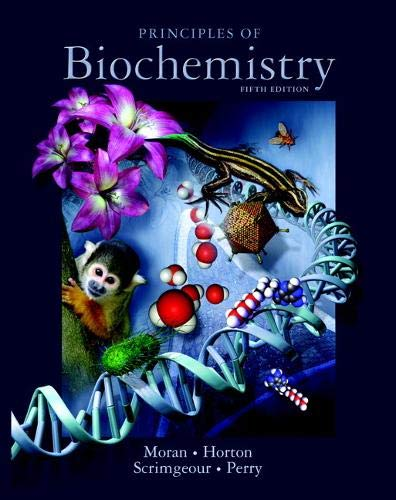Principles of Biochemistry, 5/E

Laurence A. Moran, University of Toronto
Robert A Horton, North Carolina State University
Gray Scrimgeour, University of Toronto
Marc Perry, University of Toronto
ISBN-10: 0321707338
ISBN-13: 9780321707338
Publisher: Prentice Hall
Copyright: 2012Principles of Biochemistry, 5e (Moran/Horton/Scrimgeour/Perry/Rawn)
Chapter 5 Properties of Enzymes1) Which of the following statements is FALSE?
A) Enzymes make reactions 103 to 1020 times faster.
B) Enzymes lower the amount of energy needed for a reaction.
C) Enzymes are chemically unchanged during the actual catalytic process.
D) Enzymes speed up the attainment of a reaction equilibrium.
E) Enzymes are usually proteins.
Answer: C
Page Ref: 5-Introduction
2) Which of the following statements is FALSE?
A) The word enzyme is from a Greek word meaning "in yeast."
B) Enzymes are always made of protein.
C) The first enzyme was crystallized in 1926.
D) Enzymes can couple two different reactions.
Answer: B
Page Ref: 5-Introduction
3) Unlike typical catalyzed reactions in organic chemistry enzyme reactions are
A) usually stereospecific.
B) reaction specific.
C) essentially 100% efficient.
D) modulated to change activity levels.
E) All of the above.
Answer: E
Page Ref: 5-Introduction
4) The hydrophobic cleft in globular proteins which bind substrate molecules is called the ________.
A) substrate pocket
B) modulator site
C) active site
D) activity site
E) oligomeric site
Answer: C
Page Ref: 5-Introduction
5) Most of the known enzymes are ________.
A) oxidoreductases
B) transferases
C) hydrolases
D) lyases
E) isomerases
Answer: C
Page Ref: Section 5-1
6) An enzyme that catalyzes conversions of L-sugars to D-sugars is called a(n) ________.
A) lyase
B) hydrolase
C) synthetase
D) synthase
E) isomerase
Answer: E
Page Ref: Section 5-1
7) Oxidases, peroxidases, oxygenases or reductases are all
A) lyases.
B) synthases.
C) synthetases.
D) oxidoreductases.
E) hydrolases.
Answer: D
Page Ref: Section 5-1
8) Enzymes that join two substrates and require energy of a nucleoside triphosphate (such as ATP) to do so are called
A) isomerases.
B) lyases.
C) ligases.
D) synthetases.
E) Both c and d.
Answer: E
Page Ref: Section 5-1
9) In a first order enzyme-catalyzed reaction, the velocity of the reaction is proportional to the ________, while in a zero order enzyme-catalyzed reaction, the velocity of the reaction is proportional to the ________.
A) amount of enzyme; concentration of substrate
B) concentration of substrate; amount of enzyme
C) concentration of substrate; speed of the reaction
D) speed of the reaction; concentration of substrate
Answer: B
Page Ref: Section 5-2
10) The main difference between chemical and enzyme kinetics is that
A) enzyme reactions are altered by pH.
B) enzyme reactions depend on the concentration of the substrate.
C) enzyme reactions depend on the concentration of the enzyme and its recycling.
D) the rate constant for the formation of products is k2.
Answer: C
Page Ref: Section 5-2
11) When two different substrates react to form two different products, the rate constants for each separate substrate can be determined by
A) varying one substrate at a time, keeping the other in excess.
B) varying both substrates and measuring the appearance of the two products.
C) limiting one substrate and varying the other.
D) keeping both substrate concentrations high and detecting one product at a time.
Answer: A
Page Ref: Section 5-2
12) When there are two substrates in a reaction, the reaction is said to be second order if ________.
A) the reaction is first order with respect to each substrate concentration
B) the maximum rate is independent of either substrate's concentration
C) the substrate concentrations are equal
D) it proceeds at twice the rate upon double the concentrations of both substrates
Answer: A
Page Ref: Section 5-2
13) The non-enzymatic hydrolysis of sucrose into glucose and fructose is an example of a pseudo first-order reaction because
A) no enzymes are involved.
B) water has no role in the reaction.
C) water is of such high concentration as to be considered constant.
D) water is present at concentrations proportional to the sucrose.
Answer: C
Page Ref: Section 5-2
14) In an enzyme reaction involving one enzyme and one substrate, the rate of the reaction depends on
A) substrate concentration.
B) enzyme concentration.
C) both substrate and enzyme concentrations.
D) the enzyme concentration at first and the substrate concentration later on.
Answer: C
Page Ref: Section 5-2
15) Which step in an enzyme-catalyzed reaction was assumed to be negligible by Michaelis and Menton?
A) Formation of ES from E + P.
B) Formation of E + P from ES.
C) Conversion of ES to E + S.
D) Formation of ES from E + S.
Answer: A
Page Ref: Section 5-2
To view the rest, download the attachment